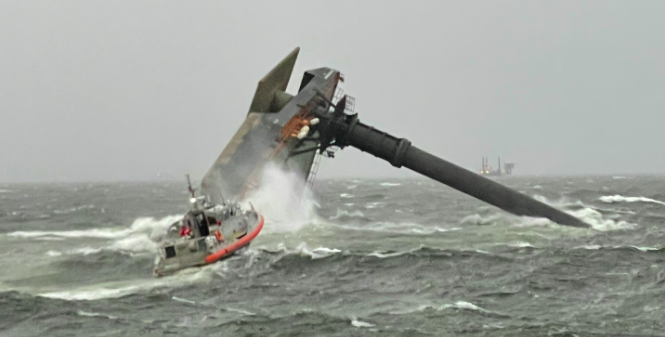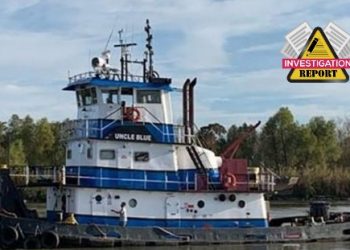The National Transportation Safety Board (NTSB) opened the public docket as part of its ongoing investigation regarding the fatal capsizing of the Seacor Power liftboat near Port Fourchon, Louisiana.
To remind, on May 19th, 2021, NTSB shared a preliminary report on Seacor Power. At the time of the accident, there were 19 people aboard the US-flagged, 175-foot-long Seacor Power. Six people were rescued by the US Coast Guard and Good Samaritan vessels, six people died in the accident, and seven remain missing but presumed dead. The Seacor Power was built in 2002 and acquired by Seacor Marine LLC in 2012. It was operated by Seacor Marine and chartered to Talos Energy at the time of the accident.
[smlsubform prepend=”GET THE SAFETY4SEA IN YOUR INBOX!” showname=false emailtxt=”” emailholder=”Enter your email address” showsubmit=true submittxt=”Submit” jsthanks=false thankyou=”Thank you for subscribing to our mailing list”]
According to the NTSB, as a rain squall passed over the vessel, visibility dropped and winds increased significantly. For this reason, the crew decided to lower the Seacor Power’s legs to the seafloor to hold the vessel in position until the storm passed. After that, the crewmember at the helm attempted to turn the vessel into the winds. However, before the turn was completed, the Seacor Power heeled to starboard and capsized.
Currently, the public docket contains only factual information without conclusions on how or why the Seacor Power capsized. It includes more than 8,000 pages of factual information, including interview transcripts, a meteorology report and other investigative materials.
As informed, in a trascript of investigators’ interview with Seacor Power’s First Mate, he describes “white out” conditions and being on the bridge with the Captain, Captain David Ledet, as the vessel capsized.
Soon as I started jacking, we started getting a starboard list, and I told [the Captain], we got a little starboard list
…the First Mate said. He then got a call from the galley reporting water coming in.
And then I looked back up at the list, and I said, [Captain], I think we’re going over. He come and took the controls, and we got another call from the galley about the galley door… Then [the Captain] grabbed the Gai-Tronics, and said, get your lifejacket, get your lifejacket, get your life jacket
…he continued.
The First Mate realized that the capsizing was approaching, so he hit the Seacor Power’s “tilt alarm” as it was “the only alarm I knew that would work for sure.”
[The Captain] stayed at the wheel trying to correct, steer into it. And then I grabbed the door, and that’s when we rolled. [The Captain] went through the windows
…the First Mate said.
The body of Captain David Ledet was recovered along with six others on the day of the accident.
According to the preliminary report of NTSB, the Seacor Power departed Port Fourchon at about 1:30 p.m. April 13, bound for the oil and gas lease area Main Pass Block 138 in the Gulf of Mexico. A weather report emailed to the vessel at 7:02 a.m. that day predicted afternoon winds at 9 to 12 knots from the southeast with 3-foot seas.
With visibility dropping and winds increasing significantly, the crew decided to lower the Seacor Power’s legs to the seafloor to hold the vessel in position until the storm passed. The crewmember at the helm attempted to turn the Seacor Power into the wind as the legs began to descend. Before the turn was completed, the liftboat heeled to starboard and capsized.
NTSB investigators also learned several people were able to escape onto the exposed, port side of the Seacor Power deckhouse. High winds and seas that had built to 10 to 12 feet prevented rescuers from reaching those who remained on the liftboat. Some were washed into the water and six were eventually rescued, with one survivor suffering a serious injury.































































